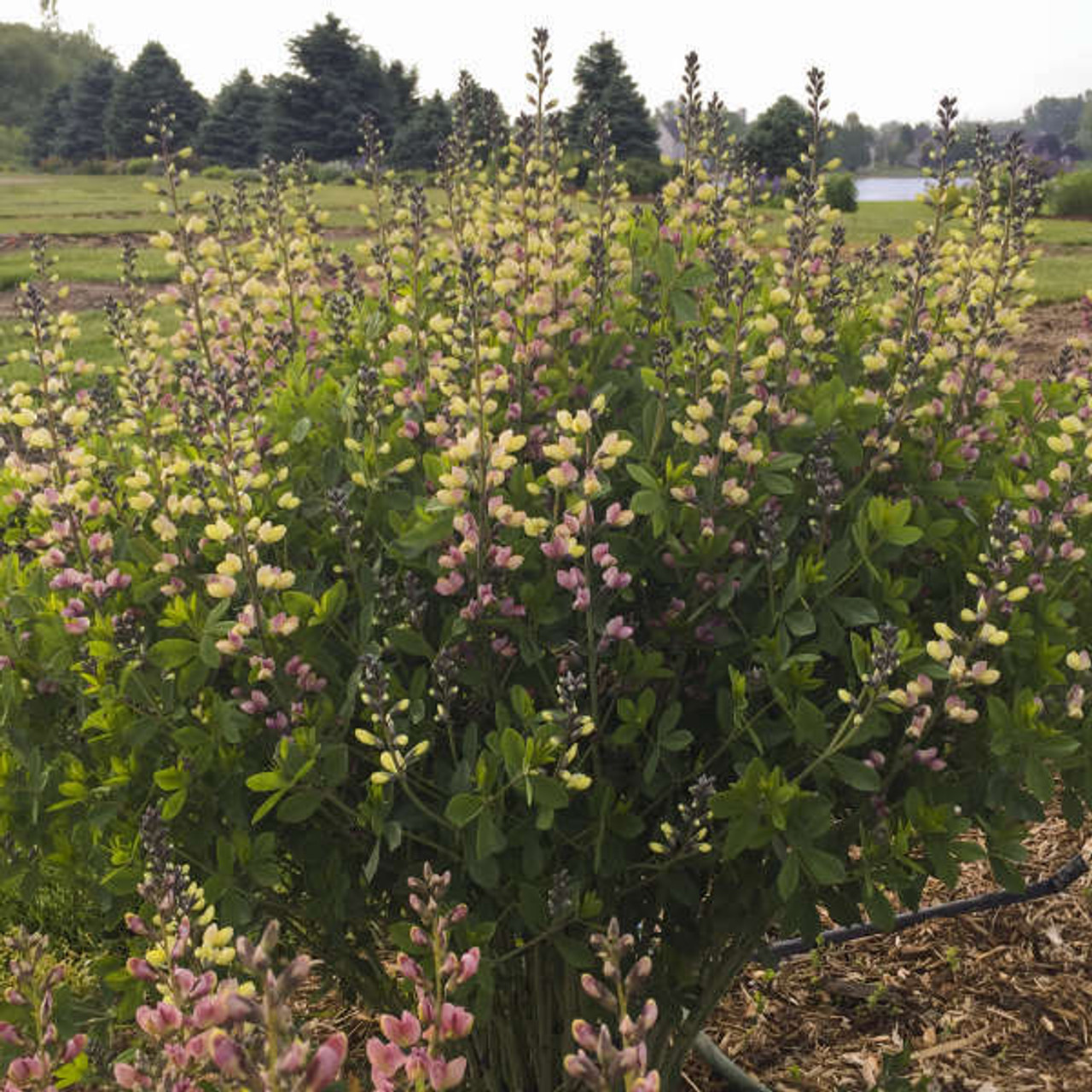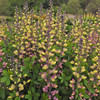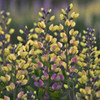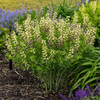Product Description
Baptisia 'Pink Lemonade' PP30669 CPBR6255 (25) Bare Root Plants
DECADENCE® Series
Common Name: False Indigo
When you have so many colorful members of the DECADENCE® Baptisia, it's hard to imagine a new hue! However, 'Pink Lemonade' does just that with its unique bicolor flower spikes, the first bicolor of the series. In late spring to early summer, soft yellow flowers age to dusty raspberry purple, and both colors appear on the stem at the same time. Charcoal stems really make the colors pop. Forms an incredibly full and bushy habit-a perfect substitution for shrubs if you're looking for structure in the garden. 'Pink Lemonade' is part of a subgroup DECADENCE® DELUXE, a reference to its taller, vase-shaped habit. It joins 'Pink Truffles', a solid pink counterpart.
Baptisia is easy to grow and will thrive with little maintenance. There are many potential applications in the landscape including meadow plantings, as a backdrop in borders, or as a specimen. Plants are very long-lived once established.
The roots of the DECADENCE® series run deep. What started as a fun botanizing trip in the lower Midwest with a fellow horticulturist blossomed into a complex hybridizing project for breeder Hans Hansen. Hans has made countless crosses with the many native Baptisia species he has collected across Texas and Oklahoma. These crosses have resulted in an array of seedlings with unique flower colors and plant habits. Only the very best have made it into the new DECADENCE® Series, which includes varieties selected for their desirable flower colors and shorter, more compact habit.
Baptisia grows best in full sun, though it tolerates light shade. If grown in too much shade, plants may require staking. Baptisia is easily grown in poor to average soil that is well-drained. Once established, it is moderately drought tolerant because of its tough, deep taproot. This perennial native may take a couple of seasons to become established but is very long-lived once mature. Avoid disturbing established clumps.
Height: 3.5-4.0 Feet
Spread: 4.0 Feet
Hardiness Zones: 4,5,6,7,8,9
Flower Color: Yellow - Pink shades
Foliage Color: Green shades
Full Sun (> 6 hrs. Direct Sun) to Part Shade (4-6 hrs. Direct Sun)
Low to Average Water Needs
Poor to Average Soil Quality
Bloomtime: Late Spring to Early Summer
Attracts Butterflies
Bee Friendly
Deer Resistant
Growth Rate: Medium
Border Plant, Cut Flower, Cut Foliage, Dried Flower, Drought Tolerant, Easy To Grow, Salt Tolerant
Baptisia 'Pink Lemonade' is a truly unique perennial with a captivating bicolor display. This standout plant features spikes of soft yellow flowers that mature to a delightful raspberry-purple, creating a stunning contrast against its deep blue-green foliage and charcoal stems. As a member of the Decadence Deluxe Series, this hybrid false indigo cultivar is known for its upright, compact habit and long-lasting blooms. It is an excellent choice for gardeners seeking a low-maintenance, drought-tolerant plant that adds a vibrant touch to any landscape.
Baptisia 'Pink Lemonade' is a North American native plant that offers a unique and beautiful addition to any garden. The genus name Baptisia comes from the Greek word "bapto" meaning "to dye," and the common name "false indigo" refers to its historical use by early American colonists as a substitute for true indigo (Indigofera) in making dyes. This fascinating history adds another layer of interest to this already remarkable plant. Here are some key characteristics of Baptisia 'Pink Lemonade':
- Mature Size: Reaches up to 4 feet tall and wide, with flower racemes up to 2 feet long.
- Flower Color: The flowers emerge a soft yellow and gradually mature to a beautiful raspberry-mauve pink, with both colors often present on the plant simultaneously. This unique bicolor display is a defining feature of 'Pink Lemonade'.
- Foliage: Features attractive blue-green foliage that forms a lush, bushy, vase-shaped clump, providing structure and a lovely backdrop for other plants in the garden.
- Seedpods: If left untrimmed after flowering, the plant develops interesting seedpods that turn charcoal-black in the fall and persist into winter, adding visual interest to the garden.
- Host Plant: Baptisia 'Pink Lemonade' serves as a host plant for several butterfly species, including the Wild Indigo Duskywing, Eastern Tailed-Blue, Clouded Sulphur, and Orange Sulphur.
- Alternative to Shrubs: With its full and bushy habit, Baptisia 'Pink Lemonade' can be a great substitute for shrubs in the garden, providing structure and visual interest.
Care Requirements One of the most appealing aspects of Baptisia 'Pink Lemonade' is its low-maintenance nature. It thrives with minimal care and is a great choice for busy gardeners.
- Sunlight While Baptisia 'Pink Lemonade' prefers full sun (at least 6 hours per day), it can tolerate light shade. However, if planted in too much shade, it may become leggy and require staking.
- Soil This adaptable plant is not picky about soil and can grow well in poor to average soil, as long as it is well-drained.
- Water Baptisia 'Pink Lemonade' is moderately drought tolerant once established, thanks to its tough, deep taproot. Water regularly during the first growing season to help establish a strong root system. After that, it requires minimal watering, except during periods of extreme heat.
Planting Proper planting is essential for the long-term health and success of your Baptisia 'Pink Lemonade'. Here are some key planting guidelines:
- Timing: Plant in early spring or fall when the weather is cooler.
- Location: Choose a location that receives full sun to partial shade.
- Soil Preparation: Ensure the soil is well-drained. Amend heavy clay or sandy soil with compost or other organic matter to improve drainage and nutrient content.
- Planting Depth and Spacing: Dig a hole as deep as the root ball and twice as wide. Place the plant in the hole, ensuring the top of the root ball is level with the soil surface. Space plants 3'10" to 4' apart to allow for mature spread.
- Watering After Planting: Water thoroughly after planting to settle the soil and eliminate air pockets.
Maintenance Once established, Baptisia 'Pink Lemonade' requires very little maintenance. Here are some basic care tips:
- Watering: Water occasionally, especially during hot, dry periods.
- Mulching: Apply a layer of mulch around the base of the plant to help retain soil moisture, regulate soil temperature, and suppress weeds.
- Fertilizing: Apply a balanced, slow-release fertilizer in early spring to support healthy growth and flowering. Avoid over-fertilizing, as this can lead to excessive foliage growth at the expense of flowers.
- Pruning: Deadheading is not necessary, as it does not significantly promote reblooming. You can cut back the foliage in late fall or early spring to maintain a tidy appearance and encourage vigorous growth. However, if you do this, you will miss out on the attractive seedpods.
- Support: The plant may need support as the summer progresses, especially if grown in partial shade.
- Pest and Disease Management: Baptisia 'Pink Lemonade' is generally pest and disease resistant. However, monitor for common garden pests and fungal diseases, and treat as needed.
- Winter Care: No winter protection is typically needed in zones 4-9.
Growth Habits Baptisia 'Pink Lemonade' exhibits a robust growth pattern, reaching a mature height and spread of 3'6" to 4'. It spreads by underground rhizomes, gradually expanding to form a substantial clump. It is important to note that it may take 2-3 years for this plant to reach maturity and produce significant flowering.
Baptisia 'Pink Lemonade' is a remarkable perennial that offers a unique blend of beauty and practicality. Its stunning bicolor flowers, attractive foliage, and long lifespan make it a valuable addition to any garden. The plant's adaptability to a range of conditions, including drought, humidity, and salt. With its low-maintenance requirements and ability to attract pollinators, Baptisia 'Pink Lemonade' is an excellent choice for gardeners of all levels who seek a long-lasting and vibrant addition to their landscapes.
Other Details
The most important part of the plant is its root system. Healthy roots are the foundation of a healthy, vibrant plant. The type of plug container used is based on the specific needs of the plants. Perennials offered as bare root traditionally perform better when planted as bare root.Planted in a specialized mix, potted plants have well established root systems. Top growth stage will vary depending on the current life cycle and time of year when shipped. In Winter and early Spring dormant plants may be shipped. Dormant plants may be planted right away, even before the last frost date.
Most bare root varieties are field grown for at least one season, though Hemerocallis and Hosta are grown for two seasons. The bulk of the soil is removed during the harvesting process and the tops of most varieties are trimmed back to the crown. They are graded, packed in shredded aspen or sphagnum moss and stored in freezers until ready to be shipped.
See our Container Sizes and Bare Root Perennials pages for more information.
Plant information and care is provided in the Overview section, Plant Genus Page and general information is provided in the Planting Care & Guides. Additional questions can be asked on each Plant page.
Plant Spacing: Using the maximum mature spread or width of a plant to guide spacing, ensures space to grow to full size. To fill an area sooner, plant them closer together. Just remember, future thinning or transplanting may be needed.
Water: Keep a close eye on newly planted perennials, especially throughout the first growing year. Most early plant loss is due to too much or too little water!














